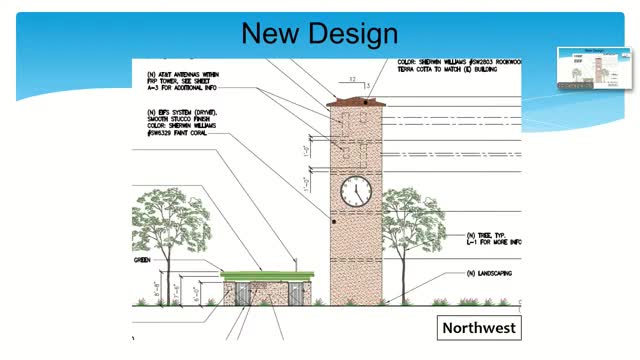Cell tower proposal sparks community debate over health and aesthetics
July 18, 2024 | Cathedral City, Riverside County, California

This article was created by AI summarizing key points discussed. AI makes mistakes, so for full details and context, please refer to the video of the full meeting. Please report any errors so we can fix them. Report an error »

In a recent planning commission meeting, discussions centered around the proposed construction of a new telecommunications facility featuring a clock tower at a local church site. The clock tower is set to be painted faint coral with a smooth stucco finish, complemented by a metal roof painted to match the existing church building. The design aims to blend with the church's aesthetics while addressing the community's need for improved cell service.
The proposed facility, which includes a 53-foot clock tower, is expected to significantly enhance indoor signal strength for nearby residents. However, concerns were raised by local residents regarding potential health risks associated with radiation from the new antenna, as well as the visual impact of the structure on the surrounding area. Some residents argued that additional towers were unnecessary, citing existing coverage from nearby facilities.
Federal regulations, specifically Section 332(c)(7) of the Federal Communications Act, limit local governments' ability to regulate wireless facilities based on environmental effects of radio frequency emissions. This means that as long as the proposed facility complies with federal guidelines, local authorities cannot deny the project based on health concerns alone.
During the public hearing, representatives from the church expressed their commitment to the project, emphasizing its potential benefits for the community, particularly in enhancing cell reception for residents. The church has been in discussions with AT&T for approximately three years to ensure the design aligns with community standards and does not detract from the church's appearance.
The planning commission staff recommended that the project be exempt from the California Environmental Quality Act (CEQA) based on specific findings and conditions of approval. The church's representatives confirmed that the clock tower would be maintained and operational at all times, addressing concerns about its upkeep.
As the meeting concluded, commissioners acknowledged the challenges of balancing community aesthetics with the need for improved telecommunications infrastructure, while also recognizing the limitations imposed by federal law on local regulatory authority. The project is now set to move forward, pending final approvals.
The proposed facility, which includes a 53-foot clock tower, is expected to significantly enhance indoor signal strength for nearby residents. However, concerns were raised by local residents regarding potential health risks associated with radiation from the new antenna, as well as the visual impact of the structure on the surrounding area. Some residents argued that additional towers were unnecessary, citing existing coverage from nearby facilities.
Federal regulations, specifically Section 332(c)(7) of the Federal Communications Act, limit local governments' ability to regulate wireless facilities based on environmental effects of radio frequency emissions. This means that as long as the proposed facility complies with federal guidelines, local authorities cannot deny the project based on health concerns alone.
During the public hearing, representatives from the church expressed their commitment to the project, emphasizing its potential benefits for the community, particularly in enhancing cell reception for residents. The church has been in discussions with AT&T for approximately three years to ensure the design aligns with community standards and does not detract from the church's appearance.
The planning commission staff recommended that the project be exempt from the California Environmental Quality Act (CEQA) based on specific findings and conditions of approval. The church's representatives confirmed that the clock tower would be maintained and operational at all times, addressing concerns about its upkeep.
As the meeting concluded, commissioners acknowledged the challenges of balancing community aesthetics with the need for improved telecommunications infrastructure, while also recognizing the limitations imposed by federal law on local regulatory authority. The project is now set to move forward, pending final approvals.
View full meeting
This article is based on a recent meeting—watch the full video and explore the complete transcript for deeper insights into the discussion.
View full meeting
